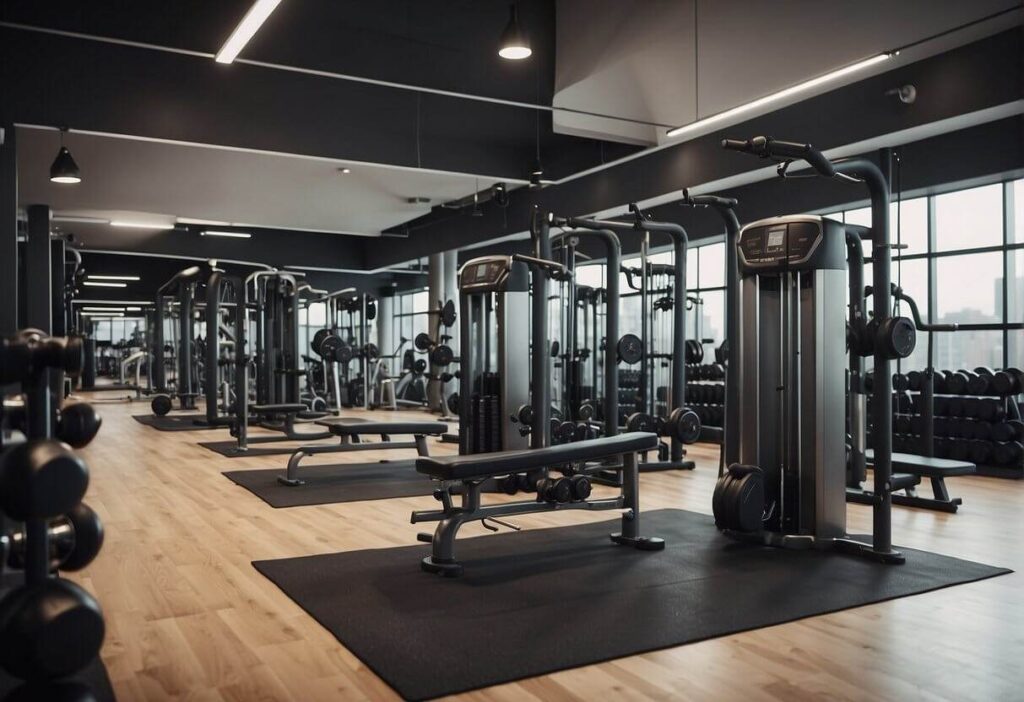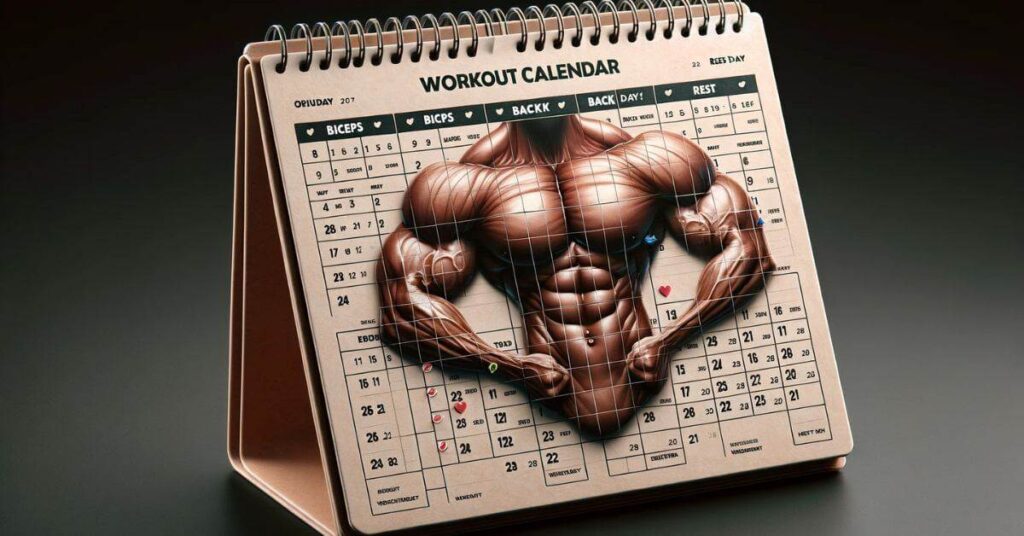When planning your workout routine, it can sometimes be difficult to figure out the best order to train your muscles.
Maybe you’ve heard some gym buddies or online forums debate about whether it’s a wise move to exercise your biceps before diving into your back workout.
It’s a topic that stirs up plenty of opinions, each backed by personal anecdotes and different training philosophies.

The crux of the matter lies in understanding how these muscles work together during your training. Your biceps aren’t just there to look good; they play a supporting role in many back exercises.
This means when you’re heaving weights during rows or pull-ups, your biceps are pitching in to help with the movement.
So, if you’re considering a solid bicep workout before hitting your back, it’s crucial to realise that this could lead to pre-fatiguing your arms, potentially impacting your ability to smash those back exercises with maximum efficiency.
However, everyone’s body responds differently to exercise, and what might be a golden rule for one, could be less effective for another.
It’s important to try out different sequences and see how your body reacts.
Remember, the goal of any good training plan is to maximise muscle growth and strength gains while minimising the risk of injury. So, experimenting with careful attention to how your muscles feel and perform could guide you to your optimal personal workout strategy.
Key Takeaways
- Training biceps before back can pre-fatigue arms, affecting back workout efficiency.
- Muscle response varies; experimentation with exercise order is essential.
- Aim for balanced muscle development and injury prevention.
- Understanding muscle anatomy and workout planning fundamentals enhances training effectiveness.
Understanding Muscle Anatomy
When you’re aiming to get those muscles in your arms and back just right, knowing what’s under your skin is super important. Let’s dive into the nitty-gritty of your muscle makeup so your workouts can be as spot-on as possible.
Biceps Muscle Complex
Your biceps are more than just show muscles; they’re pivotal for pulling movements! This duo, known as the biceps brachii, has a couple of heads called the long head and the short head. They run down the front of your upper arm.
But don’t forget the brachialis – this powerful guy sits just below your biceps, and when it comes to curls, it’s pulling its weight too. There’s also the brachioradialis, a muscle that stretches from your mid-forearm to just above the elbow, pitching in during those flexing moves.
Back Muscle Groups
Switching to your back, picture your lats as the broad wings that give the “V” shape you’re after. Officially known as latissimus dorsi, these large muscles are key for pulling and lifting movements.
Your trapezius muscles, or traps for short, aren’t just a single muscle; they’re a group that extends from your neck and along your spine, helping you with all sorts of moves from shrugging to rowing. These muscles, along with a few others, work together like a well-oiled machine, setting the scene for a strong and sturdy upper body.
Workout Planning Fundamentals

When you’re planning your workout, it’s crucial to understand the why and how behind the order of exercises and the structure of your training split. These factors can determine how effective your workouts are for your fitness goals.
Exercise Order Importance
The sequence in which you perform exercises can significantly impact the quality of your workout.
For instance, training smaller muscle groups, such as your biceps, before larger ones, like your back, can affect your performance.
Muscles required for larger compound movements might not be fully activated if they are preceded by exercises targeting smaller muscles.
Particularly, if you’re doing bicep curls before you tackle a back workout, your bicep fatigue may compromise your back exercises, which typically demand more training volume and energy.
Split Training Basics
In split training, you’ll divide your workouts by muscle groups or movement patterns to allow for adequate recovery and maximal effort in each session.
A classic split might have you working different muscle groups on different days—like biceps on one day and back on another.
This division lets you hold nothing back on each muscle group since you’re giving them time to recover before they’re targeted again.
Sets and reps are organised not to overtrain a muscle group, allowing for consistent progress without overtaxing your capacity to recover.
Remember, every body is unique, and gyms are full of variety, so what works for one person may not work for another. Keep it personalised!
Benefits of Training Biceps Before Back
When considering rearranging your workout to hit your biceps before tackling your back exercises, there are a couple of strategic benefits worth considering. This approach allows you to focus on smaller muscle groups with more intensity and can also serve as a strategic warm-up that helps tackle your back exercises with proper form.
Pre-Exhaustion Strategy
The pre-exhaustion strategy in muscle building is a technique where you perform an isolation exercise to fatigue a specific muscle group before moving on to a compound lift that involves the same muscle.
The idea is to tire out the targeted muscle with an isolation move so that when you transition to the compound exercise, the muscle works harder, potentially leading to increased strength and muscle growth.
For example, starting with preacher curls might mean your biceps are too tired to help much with rows or pull-ups, pushing your back muscles to pick up the slack.
Targeting Smaller Muscle Groups First
Training your smaller muscle group, such as the biceps, before your back has its advantages.
Since biceps are a smaller group, lifting heavier weights with exercises like curls is possible because you’re hitting them when you’re fresh.
This can translate to more focused growth in the biceps due to the higher intensity you’re able to apply right off the bat.
Exercise Techniques and Variations
When planning your workout, the sequence and technique of the exercises are crucial for maximising muscle engagement and growth. By understanding the nuances of each exercise, you can make informed decisions that benefit your workout structure and overall goals.
Curling for Optimal Biceps Engagement
When you’re targeting your biceps, curls should be your go-to exercise.
To get the most out of curling movements, such as the barbell curl and preacher curl, focus on maintaining a full range of motion.
This means moving from a fully extended arm to bringing the weight as close to your shoulders as possible – without swinging your body.
Concentration curls are particularly effective for hitting the biceps because they isolate the muscle and minimise momentum.
Remember to keep your elbow steady and perform each curl with control; it’s not about hoisting the heaviest weight you can grab, but rather making those bicep muscles work hard every inch of the way.
Back Exercises Selection
For your back, a mixture of compound exercises and rows can create a well-rounded workout.
Pull-ups and pulldowns effectively target the upper back, while barbell rows and dumbbell rows are excellent for engaging multiple back muscles.
Ensure you’re using a weight that allows you to maintain proper form through every set.
Cable rows are a superb addition as well; they allow for continuous tension throughout the movement, which can lead to greater muscle growth.
Be mindful to squeeze your shoulder blades together at the end of each row, really focusing on the muscles you’re working to get a solid back workout.
With these exercises, the importance of form can’t be overstressed.
Whether you’re curling for biceps or rowing for your back, always aim for quality over sheer quantity – that’s how you’ll see true progress and avoid injury.
Potential Risks of Biceps Dominant Sessions

When you place too much focus on your biceps before hitting the larger back muscles, you could be setting yourself up for a few unintended consequences. Let’s look at what could go wrong.
Risk of Muscular Imbalance
Hitting your biceps hard can lead to muscular imbalance, especially if the back muscles are not given their due attention.
Your back consists of large musculature essential for overall strength and posture.
When the biceps become fatigued from a session just before a back workout, they may compromise the performance of compound lifts, like rows or pull-ups, which require the full force of the back muscles.
Consistently doing so may lead to the overdevelopment of the biceps in comparison to your back, potentially causing posture issues and functional weaknesses.
Overemphasis on Biceps Training
Dedicating a whole session to biceps before training the back can also mean you are potentially placing too much emphasis on the biceps.
When the back, which is key to your pulling strength, is undertrained, you may find yourself struggling with lifts that require back strength or dealing with longer recovery times as the fatigued biceps can’t assist as needed.
This not only hinders your progress in achieving a balanced physique but could also increase the risk of straining your biceps since they’ll be working hard two sessions in a row.
Remember, your muscles do not work in isolation.
Prioritising the training for one muscle group over another, especially when they are closely related and often work in tandem, can disrupt your strength gains and stall your overall muscle development.
Structuring Your Workout Week

Crafting an effective workout schedule is key to achieving your fitness goals while allowing ample time for your muscles to recover. This week, let’s focus on how to effectively insert back and biceps sessions and fine-tune the recovery periods for optimal gains.
Incorporating Back and Biceps Days
When planning your workout week, it’s important to consider the relationship between different muscle groups.
Back training often involves the biceps indirectly because pulling movements typically require bicep engagement. To avoid overworking your biceps, it’s best to separate your back and biceps workouts by at least 48 hours.
If you follow a bro-split (where you train each muscle group once a week), scheduling biceps on Wednesday and back on Friday allows sufficient rest.
Alternatively, if you prefer a more frequent training cycle, consider structuring your week with a pull day (which includes back and bicep exercises) and ensure you have a rest day or leg day in between.
Optimal Recovery Times
For muscle repair and growth, recovery times are just as crucial as the workouts themselves.
After a strenuous session targeting your back or biceps, your muscles need time to repair. This typically takes about 48 to 72 hours.
However, if you still feel sore or fatigued, listen to your body and give it more time. Overtraining can lead to injuries and stifle your progress, so resist the temptation to rush this process.
If your biceps are scheduled for Thursday, ensure your back training is not until at least Saturday to facilitate recovery. Keep in mind that younger athletes might recover faster, while older individuals might need a bit more time.
Advanced Techniques for Muscle Growth

When you’re aiming to level up your workouts, knowing how to effectively boost muscle growth can be a game-changer. Let’s dig into some advanced techniques that could help you push your strength to new heights.
Integrating Supersets and Compound Sets
Supersets involve performing two exercises back-to-back with no rest in between.
This strategy challenges your muscles more than traditional sets, leading to increased muscle growth.
For example, you could pair hammer curls with reverse curls to target the biceps from different angles, which can amplify the intensity of your workout without adding time.
Example Superset Pairing for Biceps:
- Hammer Curls
- Reverse Curls
Following a superset with a seated cable row can further engage the back muscles, making it a potent choice for stacking on force.
Compound sets, on the other hand, are two consecutive exercises that hit the same muscle group. Imagine doing a set of incline dumbbell curls immediately followed by wrist curls.
Your biceps would be screaming for mercy, which is exactly what you want for that growth!
Example Compound Set for Biceps:
- Incline Dumbbell Curls
- Wrist Curls
Variability with Grip and Angles
Mixing up your grip can drastically alter how your muscles are worked.
Taking a wider or closer grip changes the stress distribution, enhancing grip strength and fostering new muscle adaptations.
Conversely, altering the angle of your workouts, like doing curls on an incline bench, targets different parts of your biceps.
Variations to Try:
- Wide Grip Biceps Curl
- Close Grip Biceps Curl
- Incline Bench Hammer Curl
Beyond the usual curls, playing with angles using the inclined bench for hammer curls positions your arms back slightly, isolating the long head of the biceps more effectively than standard curls.
Remember, using too heavy weights might tempt you to use cheating by swinging the weight up with momentum.
Focus on control and form to keep the tension where it should be—on your muscles, not your ego.
Conclusion

In exploring the interplay between biceps and back workouts, key considerations emerge around training efficiency and muscle recovery.
Summarising Biceps Before Back Approach
A pivotal point to grasp is that biceps exercises, such as curls, are isolation exercises designed specifically for the bicep muscles.
Meanwhile, the back consists of a larger group of back muscles, including lats and traps, which are activated during compound movements like rows and pull-ups.
When you perform back exercises, your biceps naturally engage as secondary muscles to support these movements.
Consequently, blasting your biceps with a high training volume the day before might lead to muscle fatigue, compromising your back workout’s focus and posture.
Final Recommendations
To maximize your benefits and build muscle effectively, consider sequencing your workouts so that your biceps have adequate recovery time after back training.
By doing so, you can apply full strength and maintain proper form during back exercises, which tend to demand more from your muscles.
If you still prefer pairing these muscle groups, limit biceps exercises to the end of your back workout to ensure they won’t impede your back training.
Remember, to foster muscular growth, balance your workout and recovery periods.






